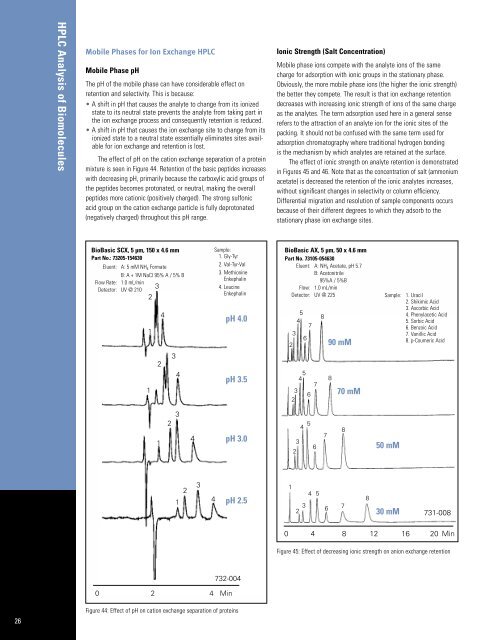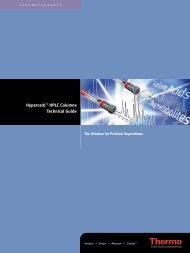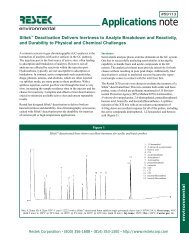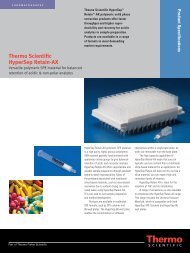HPLC Analysis of Biomolecules Technical Guide - Interscience
HPLC Analysis of Biomolecules Technical Guide - Interscience
HPLC Analysis of Biomolecules Technical Guide - Interscience
Create successful ePaper yourself
Turn your PDF publications into a flip-book with our unique Google optimized e-Paper software.
26<br />
<strong>HPLC</strong> <strong>Analysis</strong> <strong>of</strong> <strong>Biomolecules</strong><br />
Mobile Phases for Ion Exchange <strong>HPLC</strong><br />
Mobile Phase pH<br />
The pH <strong>of</strong> the mobile phase can have considerable effect on<br />
retention and selectivity. This is because:<br />
• A shift in pH that causes the analyte to change from its ionized<br />
state to its neutral state prevents the analyte from taking part in<br />
the ion exchange process and consequently retention is reduced.<br />
• A shift in pH that causes the ion exchange site to change from its<br />
ionized state to a neutral state essentially eliminates sites available<br />
for ion exchange and retention is lost.<br />
The effect <strong>of</strong> pH on the cation exchange separation <strong>of</strong> a protein<br />
mixture is seen in Figure 44. Retention <strong>of</strong> the basic peptides increases<br />
with decreasing pH, primarily because the carboxylic acid groups <strong>of</strong><br />
the peptides becomes protonated, or neutral, making the overall<br />
peptides more cationic (positively charged). The strong sulfonic<br />
acid group on the cation exchange particle is fully deprotonated<br />
(negatively charged) throughout this pH range.<br />
BioBasic SCX, 5 µm, 150 x 4.6 mm<br />
Part No.: 73205-154630<br />
Eluent: A: 5 mM NH4 Formate<br />
B: A + 1M NaCl 95% A / 5% B<br />
Flow Rate: 1.0 mL/min<br />
3<br />
Detector: UV @ 210<br />
2<br />
1<br />
1<br />
2<br />
1<br />
4<br />
Sample:<br />
1. Gly-Tyr<br />
2. Val-Tyr-Val<br />
3. Methionine<br />
Enkephalin<br />
4. Leucine<br />
Enkephalin<br />
732-004<br />
0 2 4 Min<br />
2<br />
3<br />
4<br />
3<br />
1<br />
2<br />
4<br />
3<br />
pH 4.0<br />
pH 3.5<br />
pH 3.0<br />
4 pH 2.5<br />
Figure 44: Effect <strong>of</strong> pH on cation exchange separation <strong>of</strong> proteins<br />
Ionic Strength (Salt Concentration)<br />
Mobile phase ions compete with the analyte ions <strong>of</strong> the same<br />
charge for adsorption with ionic groups in the stationary phase.<br />
Obviously, the more mobile phase ions (the higher the ionic strength)<br />
the better they compete. The result is that ion exchange retention<br />
decreases with increasing ionic strength <strong>of</strong> ions <strong>of</strong> the same charge<br />
as the analytes. The term adsorption used here in a general sense<br />
refers to the attraction <strong>of</strong> an analyte ion for the ionic sites <strong>of</strong> the<br />
packing. It should not be confused with the same term used for<br />
adsorption chromatography where traditional hydrogen bonding<br />
is the mechanism by which analytes are retained at the surface.<br />
The effect <strong>of</strong> ionic strength on analyte retention is demonstrated<br />
in Figures 45 and 46. Note that as the concentration <strong>of</strong> salt (ammonium<br />
acetate) is decreased the retention <strong>of</strong> the ionic analytes increases,<br />
without significant changes in selectivity or column efficiency.<br />
Differential migration and resolution <strong>of</strong> sample components occurs<br />
because <strong>of</strong> their different degrees to which they adsorb to the<br />
stationary phase ion exchange sites.<br />
BioBasic AX, 5 µm, 50 x 4.6 mm<br />
Part No. 73105-054630<br />
Eluent: A: NH 4 Acetate, pH 5.7<br />
B: Acetonitrile<br />
95%A / 5%B<br />
Flow: 1.0 mL/min<br />
Detector: UV @ 225<br />
2<br />
1<br />
3<br />
3<br />
2<br />
2<br />
5<br />
4<br />
3<br />
6<br />
4 5<br />
7<br />
6<br />
4 5<br />
2 3<br />
7<br />
6<br />
4 5<br />
8<br />
7<br />
6<br />
90 mM<br />
8<br />
70 mM<br />
8<br />
7<br />
Sample: 1. Uracil<br />
2. Shikimic Acid<br />
3. Ascorbic Acid<br />
4. Phenylacetic Acid<br />
5. Sorbic Acid<br />
6. Benzoic Acid<br />
7. Vanillic Acid<br />
8. p-Coumeric Acid<br />
50 mM<br />
30 mM<br />
731-008<br />
0 4 8 12 16 20 Min<br />
Figure 45: Effect <strong>of</strong> decreasing ionic strength on anion exchange retention<br />
8





